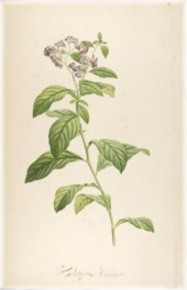Heady Heliotrope
by Audrey Stallsmith

A black cat among roses,
Phlox, lilac-misted under a first-quarter moon,
The sweet smells of heliotrope and night-scented stock.
The garden is very still,
It is dazed with moonlight,
Contented with perfume.
Amy Lowell--"The Garden by Moonlight"
Heliotrope would be an ideal flower to present to your Valentine this month because it stands for devotion. And it even has a tragic love story to go with it!
The plant was supposedly named for Clytie, a water nymph who pined away for love of Apollo (the Greek sun god). Now rooted to earth, she constantly follows his passage across the sky. The name of her bloom derives from the Greek helios ("sun") and trope ("a turning").
But, since this story was already old before Heliotropium arborescens reached Europe in the 1700's, it's likely that the legend refers to some other plant. To Heliotropium europaeum, AKA European turnsole, perhaps. Or even Heliotropium curassavicum, seaside heliotrope, since Clytie was obviously associated with water.
As heliotrope is one of those sweet, old-fashioned charmers that has fallen out of style these days, you'd probably have a hard time finding some for your light-of-life anyway! Heliotropium arborescens was originally "discovered" in the central valley of the Peruvian Cordilleras by French doctor/botanist Joseph de Jussieu, who was part of a scientific expedition sent to take measurements of latitude at the equator.
Like most plant enthusiasts, however, he kept getting distracted by the local flora--and lingered in South America for most of his life. Although the expedition left Europe in 1735, this particular member of it never got around to returning to France until 1771. By that time, he'd reportedly grown despondent over the loss of many of the specimens he'd attempted to send home, so much so that he was quite off his head when he died.
From the frequency with which heliotrope is mentioned in Victorian poetry and novels, however, we can deduce that most people of that era would have considered Jussieu's botanical career a resounding success. The flower also lent its name to a shade of reddish-lavender popular at the time.
The most-often mentioned attribute of Heliotropium arborescens (AKA Heliotropium peruviana) has always been its delicious scent, which some describe as "cherry pie," and others simply as "vanilla" or "honey-vanilla." Although some equate Heliotropium corymbosum, pictured here, with arborescens, others insist that corymbosum--while similar--has a scent more like narcissus. There has also been some debate as to whether heliotrope flowers actually do turn to follow the sun. I'll have to keep an eye on mine this summer and find out!
At any rate, heliotrope is an antique worth growing--and not just for its scent. Those loose heads of purple, lavender, or white flowers have a charm all thier own. They are at their best in late summer, after many other blooms have faded, and are supposed to have especially magical properties in August! However, since there is also a gemstone called heliotrope--AKA bloodstone--it's sometimes hard to tell which superstitions refer to it and which to the plant.
But, if you've recently been robbed, you might want to try gathering some heliotrope in August. Wrapped in a bay leaf with a wolf's tooth and put under your pillow, it will supposedly show you the thief and the location of the loot! Or the same little package, taken into a church, is supposed to root to the spot any women who have been guilty of adultery. Fortunately for those females, finding a wolf's tooth would probably be about as difficult these days as the heliotrope!
The flower is also supposed to make its bearer invisible. In his Inferno, Dante writes, "No hope had they of crevice where to hide, Or heliotrope to charm them out of view." (But, since Dante hails from the 1300's, we will again have to go with that "some other plant or possibly a stone" disclaimer!)
With the new interest in heirloom flowers, heliotrope is actually coming into view again. The cultivars named 'Marine,' 'Iowa,' and 'Fragrant Delight' are now fairly widely available. If you want the original heliotrope, however, which--as arborescens ("like a tree") implies--can grow to three or four feet tall, you may need to order it from one of the places that specializes in heirlooms.
The plant is very sensitive to frost, so you will need to bring it indoors during the winter if you wish to keep it. Perhaps the fictional female it represents was too sensitive as well. As Christina Rossetti points out "In the Willow Shade," those "who set their heart upon a hope/ That never comes to pass,/ Droop in the end like fading heliotrope/ The sun's wan looking-glass."
Plant plate and background is from Description des Plantes Rares Cultivees a Malmaison et a Navarre by Aime Bonpland, courtesy of the Missouri Botanical Garden Library.








